耐克跨国投资案列分析
- 格式:pptx
- 大小:1.29 MB
- 文档页数:20
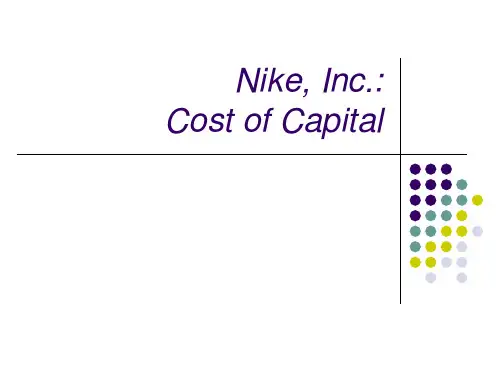
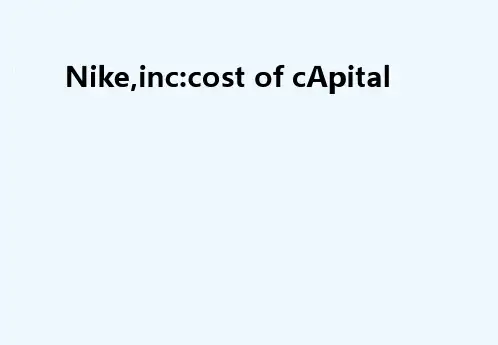
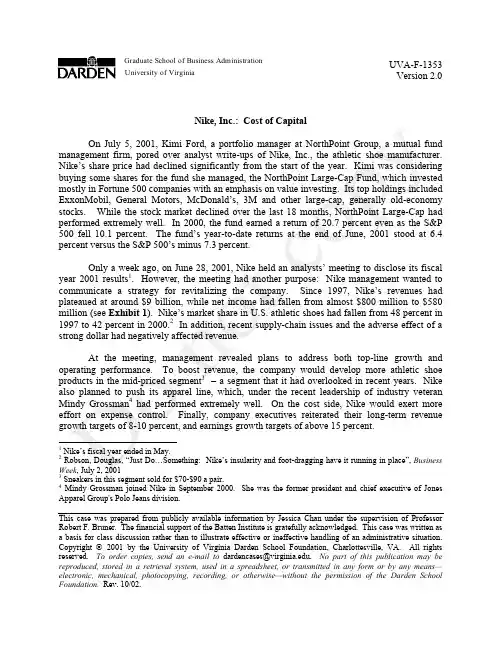
Graduate School of Business Administration University Version 2.0 of VirginiaUVA-F-1353 Version 2.0Nike, Inc.: Cost of Capital On July 5, 2001, Kimi Ford, a portfolio manager at NorthPoint Group, a mutual fund management firm, pored over analyst write-ups of Nike, Inc., the athletic shoe manufacturer. Nike’s share price had declined significantly from the start of the year. Kimi was considering buying some shares for the fund she managed, the NorthPoint Large-Cap Fund, which invested mostly in Fortune 500 companies with an emphasis on value investing. Its top holdings included ExxonMobil, General Motors, McDonald’s, 3M and other large-cap, generally old-economy stocks. While the stock market declined over the last 18 months, NorthPoint Large-Cap had performed extremely well. In 2000, the fund earned a return of 20.7 percent even as the S&P 500 fell 10.1 percent. The fund’s year-to-date returns at the end of June, 2001 stood at 6.4 percent versus the S&P 500’s minus 7.3 percent. Only a week ago, on June 28, 2001, Nike held an analysts’ meeting to disclose its fiscal year 2001 results1. However, the meeting had another purpose: Nike management wanted to communicate a strategy for revitalizing the company. Since 1997, Nike’s revenues had plateaued at around $9 billion, while net income had fallen from almost $800 million to $580 million (see Exhibit 1). Nike’s market share in U.S. athletic shoes had fallen from 48 percent in 1997 to 42 percent in 2000.2 In addition, recent supply-chain issues and the adverse effect of a strong dollar had negatively affected revenue. At the meeting, management revealed plans to address both top-line growth and operating performance. To boost revenue, the company would develop more athletic shoe products in the mid-priced segment3 – a segment that it had overlooked in recent years. Nike also planned to push its apparel line, which, under the recent leadership of industry veteran Mindy Grossman4 had performed extremely well. On the cost side, Nike would exert more effort on expense control. Finally, company executives reiterated their long-term revenue growth targets of 8-10 percent, and earnings growth targets of above 15 percent.Nike’s fiscal year ended in May. Robson, Douglas, “Just Do…Something: Nike’s insularity and foot-dragging have it running in place”, Business Week, July 2, 2001 3 Sneakers in this segment sold for $70-$90 a pair. 4 Mindy Grossman joined Nike in September 2000. She was the former president and chief executive of Jones Apparel Group's Polo Jeans division.2 1This case was prepared from publicly available information by Jessica Chan under the supervision of Professor Robert F. Bruner. The financial support of the Batten Institute is gratefully acknowledged. This case was written as a basis for class discussion rather than to illustrate effective or ineffective handling of an administrative situation. Copyright 2001 by the University of Virginia Darden School Foundation, Charlottesville, VA. All rights reserved. To order copies, send an e-mail to dardencases@. No part of this publication may be reproduced, stored in a retrieval system, used in a spreadsheet, or transmitted in any form or by any means— electronic, mechanical, photocopying, recording, or otherwise—without the permission of the Darden School Foundation. Rev. 10/02.-2-UVA-F-1353Analyst reactions were mixed. Some thought the financial targets to be too aggressive; others saw significant growth opportunities in apparel and in Nike’s international businesses. Kimi Ford read all the analyst reports that she could find about the June 28 meeting, but the reports gave her no clear guidance: a Lehman Brothers report recommended a ‘Strong Buy’ while UBS Warburg and CSFB analysts expressed misgivings about the company and recommended a ‘Hold’. Kimi decided instead to develop her own discounted-cash-flow forecast to come to a clearer conclusion. Her forecast showed that at a discount rate of 12 percent, Nike was overvalued at its current share price of $42.09 (see Exhibit 2). However, she had done a quick sensitivity analysis that revealed Nike was undervalued at discount rates below 11.2 percent. Since she was about to go into a meeting, she requested her new assistant, Joanna Cohen, to estimate Nike’s cost of capital. Joanna immediately gathered all the data she thought she might need (Exhibits 1 through 4) and set out to work on her analysis. At the end of the day, she submitted her cost of capital estimate and a memo (Exhibit 5) explaining her assumptions to Ms. Ford.-3-UVA-F-1353Exhibit 1 Nike, Inc.: Cost of Capital Consolidated Income StatementsYear Ended May 31 (In millions except per share data) Revenues Cost of goods sold Gross profit Selling and administrative Operating income Interest expense Other expense, net Restructuring charge, net Income before income taxes Income taxes Net income Diluted earnings per common share Average shares outstanding (diluted) Growth (%) Revenue Operating income Net income Margins (%) Gross margin Operating margin Net margin Effective tax rate (%)* 1995 1996 1997 1998 1999 2000 20014,760.8 2,865.3 1,895.6 1,209.8 685.8 24.2 11.7 649.9 250.2 399.7 1.36 294.06,470.6 3,906.7 2,563.9 1,588.6 975.3 39.5 36.7 899.1 345.9 553.2 1.88 293.69,186.5 5,503.0 3,683.5 2,303.7 1,379.8 52.3 32.3 1,295.2 499.4 795.8 2.68 297.09,553.1 6,065.5 3,487.6 2,623.8 863.8 60.0 20.9 129.9 653.0 253.4 399.6 1.35 296.08,776.9 5,493.5 3,283.4 2,426.6 856.8 44.1 21.5 45.1 746.1 294.7 451.4 1.57 287.58,995.1 5,403.8 3,591.3 2,606.4 984.9 45.0 23.2 (2.5) 919.2 340.1 579.1 2.07 279.89,488.8 5,784.9 3,703.9 2,689.7 1,014.2 58.7 34.1 921.4 331.7 589.7 2.16 273.335.9 42.2 38.442.0 41.5 43.94.0 (37.4) (49.8)(8.1) (0.8) 13.02.5 15.0 28.35.5 3.0 1.839.6 15.1 8.5 38.540.1 15.0 8.7 38.636.5 9.0 4.2 38.837.4 9.8 5.1 39.539.9 10.9 6.4 37.039.0 10.7 6.2 36.0*The U.S. statutory tax rate was 35%. The state tax varied yearly from 2.5% to 3.5%. Source: Company's 10-K SEC filing, UBS Warburg-4Exhibit 2 Nike, Inc.: Cost of Capital Discounted Cash Flow Analysis2002 Assumptions: Revenue growth (%) COGS/Sales (%) S&A/Sales (%) Tax rate (%) Current assets/Sales (%) Current liabilities/Sales (%) Yearly depreciation and capex equal each other. Cost of capital (%) Terminal value growth rate (%) Discounted Cash Flow Operating income Taxes NOPAT Capex, net of depreciation Change in NWC Free cash flow Terminal value Total flows Present value of flows Enterprise value Less: current outstanding debt Equity value Current shares outstanding Equity value per share at 12% Sensitivity of equity value to discount rate: Discount rate 8.00% 8.50% 9.00% 9.50% 10.00% 10.50% 11.00% 11.17% 11.50% 12.00% 2003 2004 2005 2006 2007 2008 2009UVA-F-1353201020117.0 60.0 28.0 38.0 38.0 11.5 12.0 3.06.5 60.0 27.5 38.0 38.0 11.56.5 59.5 27.0 38.0 38.0 11.56.5 59.5 26.5 38.0 38.0 11.56.0 59.0 26.0 38.0 38.0 11.56.0 59.0 25.5 38.0 38.0 11.56.0 58.5 25.0 38.0 38.0 11.56.0 58.5 25.0 38.0 38.0 11.56.0 58.0 25.0 38.0 38.0 11.56.0 58.0 25.0 38.0 38.0 11.51,218.4 463.0 755.4 8.8 764.1 764.1 682.3 11,415.7 1,296.6 10,119.1 271.5 $ 37.271,351.6 513.6 838.0 (174.9) 663.1 663.1 528.61,554.6 590.8 963.9 (186.3) 777.6 777.6 553.51,717.0 652.5 1,064.5 (198.4) 866.2 866.2 550.51,950.0 741.0 1,209.0 (195.0) 1,014.0 1,014.0 575.42,135.9 811.7 1,324.3 (206.7) 1,117.6 1,117.6 566.22,410.2 915.9 1,494.3 (219.1) 1,275.2 1,275.2 576.82,554.8 970.8 1,584.0 (232.3) 1,351.7 1,351.7 545.92,790.1 1,060.2 1,729.9 (246.2) 1,483.7 1,483.7 535.02,957.5 1,123.9 1,833.7 (261.0) 1,572.7 17,998.7 19,571.5 6,301.5Current share price:$42.09Note: Terminal value is estimated using the constant growth model: Equity value $ 75.80 67.85 61.25 55.68 50.92 46.81 43.22 42.09 40.07 37.27 TV = FCF10 * (1 + Terminal value growth rate) WACC - g TV = $1,572.7 * (1.03) 12% - 3%-5Exhibit 3 Nike, Inc.: Cost of Capital Consolidated Balance SheetsMay 31, As of (In millions) Assets Current Assets: Cash and equivalents Accounts receivable Inventories Deferred income taxes Prepaid expenses Total current assets Property, plant and equipment, net Identifiable intangible assets and goodwill, net Deferred income taxes and other assets Total assets Liabilities and shareholders' equity Current Liabilities: Current portion of long-term debt Notes payable Accounts payable Accrued liabilities Income taxes payable Total current liabilities Long-term debt Deferred income taxes and other liabilities Redeemable preferred stock Shareholders' equity: Common stock, par Capital in excess of stated value Unearned stock compensation Accumulated other comprehensive income Retained earnings Total shareholders' equity Total liabilities and shareholders' equity 2000 2001UVA-F-1353$254.3 1,569.4 1,446.0 111.5 215.2 3,596.4$304.0 1,621.4 1,424.1 113.3 162.5 3,625.31,583.4 410.9 266.2 $ 5,856.91,618.8 397.3 178.2 $ 5,819.6$50.1 924.2 543.8 621.9 2,140.0 470.3 110.3 0.3$5.4 855.3 432.0 472.1 21.9 1,786.7 435.9 102.2 0.32.8 369.0 (11.7) (111.1) 2,887.0 3,136.0 $ 5,856.92.8 459.4 (9.9) (152.1) 3,194.3 3,494.5 $ 5,819.6Source: Company 10-K SEC filing.-6-UVA-F-1353Exhibit 4 Nike, Inc.: Cost of Capital Capital Market and Financial Information On or Around July 5, 2001Current yields on U.S. Treasuries 3-month 6-month 1-year 5-year 10-year 20-year 3.59% 3.59% 3.59% 4.88% 5.39% 5.74%Nike Share Price Performance Relative to S&P500: January 2000 to July 5, 20011.3 1.2 1.1 1.0 0.9 0.8 0.7 0.6 0.5 0.4 Feb-00 Aug-00 May-00 Sep-00 Feb-01 May-01 Nov-00 Jan-00 Jun-00 Jan-01 Jun-01 Jul-00 Mar-00 Apr-00 Mar-01 Dec-00 Oct-00 Apr-01 Jul-01Historical Equity Risk Premiums (1926-1999) Geometric mean 5.90% Arithmetic mean 7.50% Current Yield on Publicly Traded Nike Debt* Coupon 6.75% paid semi-annually Issued 07/15/96 Maturity 07/15/21 Current Price $ 95.60 Nike Historic Betas 1996 1997 1998 1999 2000 YTD 06/30/00 AverageNikeS&P 5000.98 0.84 0.84 0.63 0.83 0.69 0.80Nike share price on July 5, 2001: Dividend History and Forecasts Paymt Dates 31-Mar 30-Jun 1997 0.10 0.10 1998 0.12 0.12 1999 0.12 0.12 2000 0.12 0.12 2001 0.12 0.12$42.0930-Sep 0.10 0.12 0.12 0.1231-Dec 0.10 0.12 0.12 0.12Total 0.40 0.48 0.48 0.48Consensus EPS estimates: FY 2002 FY 2003 $ 2.32 $ 2.67Value Line Forecast of Dividend Growth from '98-00 to '04-'06: 5.50%* Data have been modified for teaching purposes. Sources of data: Bloomberg Financial Services, Ibbotson Associates Yearbook 1999, Value Line Investment Survey, IBES-7Exhibit 5 Nike, Inc.: Cost of Capital Joanna’s Analysis TO: FROM: DATE: SUBJECT: Kimi Ford Joanna Cohen July 6, 2001 Nike’s Cost of CapitalUVA-F-1353Based on the following assumptions, my estimate of Nike’s cost of capital is 8.4 percent: I. Single or Multiple Costs of Capital? The first question I considered was whether to use single or multiple costs of capital given that Nike has multiple business segments. Aside from footwear, which makes up 62 percent of revenue, Nike also sells apparel (30 percent of revenue) that complement its footwear products. In addition, Nike sells sport balls, timepieces, eyewear, skates, bats, and other equipment designed for sports activities. Equipment products account for 3.6 percent of revenue. Finally, Nike also sells some non-Nike branded products such as Cole-Haan dress and casual footwear, and ice skates, skate blades, hockey sticks, hockey jerseys and other products under the Bauer trademark. Non-Nike brands account for 4.5 percent of revenue. I asked myself whether Nike’s business segments had different enough risks from each other to warrant different costs of capital. Were their profiles really different? I concluded that it was only the Cole-Haan line that was somewhat different; the rest were all sports-related businesses. However, since Cole-Haan makes up only a tiny fraction of revenues, I did not think it necessary to compute a separate cost of capital. As for the apparel and footwear lines, they are sold through the same marketing and distribution channels and are often marketed in "collections" of similar design. I believe they face the same risk factors, as such, I decided to compute only one cost of capital for the whole company. II. Methodology for Calculating the Cost of Capital: WACC Since Nike is funded with both debt and equity, I used the Weighted Average Cost of Capital (WACC) method. Based on the latest available balance sheet, debt as a proportion of total capital makes up 27.0 percent and equity accounts for 73.0 percent:-8Capital sources Book Values Debt Current portion of long-term debt $ 5.4 Notes payable 855.3 Long-term debt 435.9 $ 1,296.6 Equity III. Cost of Debt $3,494.5UVA-F-135327.0% of total capital 73.0% of total capitalMy estimate of Nike’s cost of debt is 4.3 percent. I arrived at this estimate by taking total interest expense for the year 2001 and dividing it by the company’s average debt balance.5 The rate is lower than Treasury yields but that is because Nike raised a portion of its funding needs through Japanese yen notes, which carry rates between 2.0 percent to 4.3 percent. After adjusting for tax, the cost of debt comes out to 2.7 percent. I used a tax rate of 38 percent, which I obtained by adding state taxes of 3 percent to the U.S. statutory tax rate. Historically, Nike’s state taxes have ranged from 2.5 percent to 3.5 percent. IV. Cost of Equity I estimated the cost of equity using the Capital Asset Pricing Model (CAPM). Other methods such as the Dividend Discount Model (DDM) and the Earnings Capitalization Ratio can be used to estimate the cost of equity. However, in my opinion, CAPM is the superior method. My estimate of Nike’s cost of equity is 10.5 percent. I used the current yield on 20-year Treasury bonds as my risk-free rate, and the compound average premium of the market over Treasury bonds (5.9 percent) as my risk premium. For beta I took the average of Nike’s beta from 1996 to the present. V. Putting it All Together Inputting all my assumptions into the WACC formula, my estimate of Nike’s cost of capital is 8.4 percent. WACC = Kd (1-t) * D/(D+E) + Ke * E/(D+E) = 2.7% * 27.0% + 10.5% * 73.0% = 8.4%5Debt balances as of May 31, 2000 and 2001 were $1,444.6 and $1,296.6 respectively.。
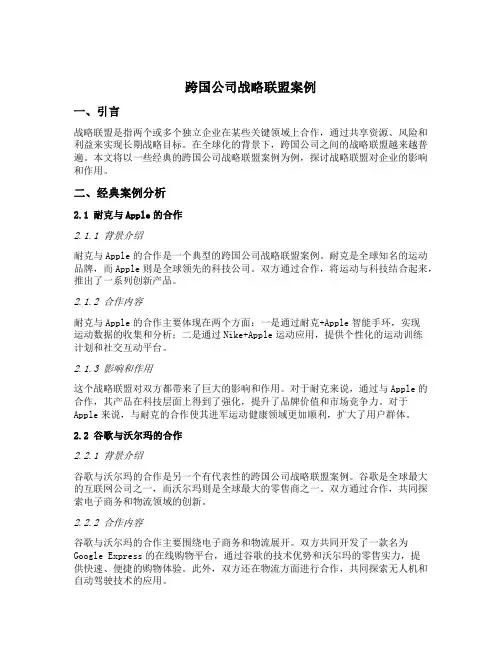
跨国公司战略联盟案例一、引言战略联盟是指两个或多个独立企业在某些关键领域上合作,通过共享资源、风险和利益来实现长期战略目标。
在全球化的背景下,跨国公司之间的战略联盟越来越普遍。
本文将以一些经典的跨国公司战略联盟案例为例,探讨战略联盟对企业的影响和作用。
二、经典案例分析2.1 耐克与Apple的合作2.1.1 背景介绍耐克与Apple的合作是一个典型的跨国公司战略联盟案例。
耐克是全球知名的运动品牌,而Apple则是全球领先的科技公司。
双方通过合作,将运动与科技结合起来,推出了一系列创新产品。
2.1.2 合作内容耐克与Apple的合作主要体现在两个方面:一是通过耐克+Apple智能手环,实现运动数据的收集和分析;二是通过Nike+Apple运动应用,提供个性化的运动训练计划和社交互动平台。
2.1.3 影响和作用这个战略联盟对双方都带来了巨大的影响和作用。
对于耐克来说,通过与Apple的合作,其产品在科技层面上得到了强化,提升了品牌价值和市场竞争力。
对于Apple来说,与耐克的合作使其进军运动健康领域更加顺利,扩大了用户群体。
2.2 谷歌与沃尔玛的合作2.2.1 背景介绍谷歌与沃尔玛的合作是另一个有代表性的跨国公司战略联盟案例。
谷歌是全球最大的互联网公司之一,而沃尔玛则是全球最大的零售商之一。
双方通过合作,共同探索电子商务和物流领域的创新。
2.2.2 合作内容谷歌与沃尔玛的合作主要围绕电子商务和物流展开。
双方共同开发了一款名为Google Express的在线购物平台,通过谷歌的技术优势和沃尔玛的零售实力,提供快速、便捷的购物体验。
此外,双方还在物流方面进行合作,共同探索无人机和自动驾驶技术的应用。
2.2.3 影响和作用这个战略联盟对双方都带来了显著的影响和作用。
对于谷歌来说,与沃尔玛的合作拓展了其电子商务业务,提升了用户体验和市场份额。
对于沃尔玛来说,与谷歌的合作加速了其数字化转型,提升了供应链效率和竞争力。
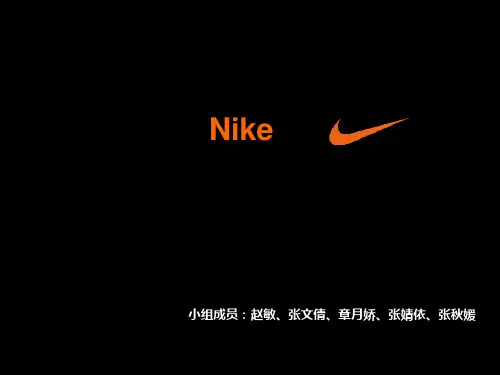
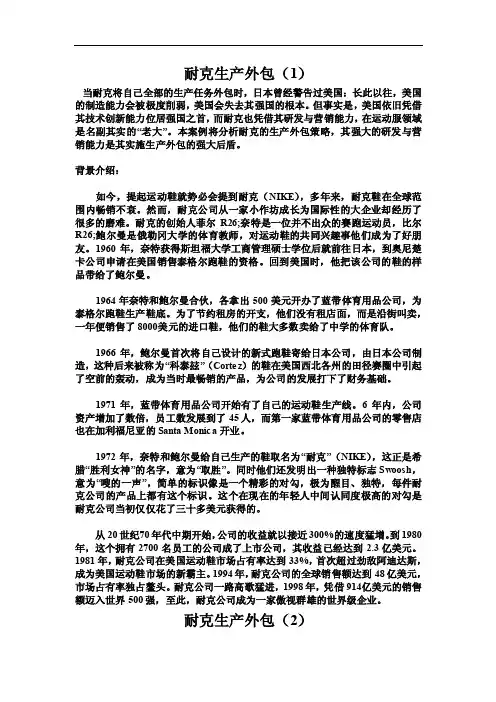
耐克生产外包(1)当耐克将自己全部的生产任务外包时,日本曾经警告过美国:长此以往,美国的制造能力会被极度削弱,美国会失去其强国的根本。
但事实是,美国依旧凭借其技术创新能力位居强国之首,而耐克也凭借其研发与营销能力,在运动服领域是名副其实的“老大”。
本案例将分析耐克的生产外包策略,其强大的研发与营销能力是其实施生产外包的强大后盾。
背景介绍:如今,提起运动鞋就势必会提到耐克(NIKE),多年来,耐克鞋在全球范围内畅销不衰。
然而,耐克公司从一家小作坊成长为国际性的大企业却经历了很多的磨难。
耐克的创始人菲尔R26;奈特是一位并不出众的赛跑运动员,比尔R26;鲍尔曼是俄勒冈大学的体育教师,对运动鞋的共同兴趣事他们成为了好朋友。
1960年,奈特获得斯坦福大学工商管理硕士学位后就前往日本,到奥尼楚卡公司申请在美国销售泰格尔跑鞋的资格。
回到美国时,他把该公司的鞋的样品带给了鲍尔曼。
1964年奈特和鲍尔曼合伙,各拿出500美元开办了蓝带体育用品公司,为泰格尔跑鞋生产鞋底。
为了节约租房的开支,他们没有租店面,而是沿街叫卖,一年便销售了8000美元的进口鞋,他们的鞋大多数卖给了中学的体育队。
1966年,鲍尔曼首次将自己设计的新式跑鞋寄给日本公司,由日本公司制造,这种后来被称为“科泰玆”(Cortez)的鞋在美国西北各州的田径赛圈中引起了空前的轰动,成为当时最畅销的产品,为公司的发展打下了财务基础。
1971年,蓝带体育用品公司开始有了自己的运动鞋生产线。
6年内,公司资产增加了数倍,员工数发展到了45人,而第一家蓝带体育用品公司的零售店也在加利福尼亚的Sa nta Monica开业。
1972年,奈特和鲍尔曼给自己生产的鞋取名为“耐克”(NIKE),这正是希腊“胜利女神”的名字,意为“取胜”。
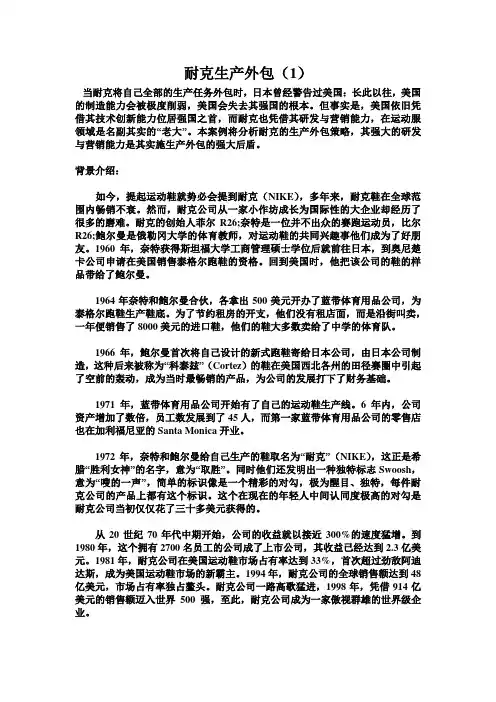
当耐克将自己全部的生产任务外包时,日本曾经警告过美国:长此以往,美国的制造能力会被极度削弱,美国会失去其强国的根本。
但事实是,美国依旧凭借其技术创新能力位居强国之首,而耐克也凭借其研发与营销能力,在运动服领域是名副其实的“老大”。
本案例将分析耐克的生产外包策略,其强大的研发与营销能力是其实施生产外包的强大后盾。
背景介绍:如今,提起运动鞋就势必会提到耐克(NIKE),多年来,耐克鞋在全球范围内畅销不衰。
然而,耐克公司从一家小作坊成长为国际性的大企业却经历了很多的磨难。
耐克的创始人菲尔R26;奈特是一位并不出众的赛跑运动员,比尔R26;鲍尔曼是俄勒冈大学的体育教师,对运动鞋的共同兴趣事他们成为了好朋友。
1960年,奈特获得斯坦福大学工商管理硕士学位后就前往日本,到奥尼楚卡公司申请在美国销售泰格尔跑鞋的资格。
回到美国时,他把该公司的鞋的样品带给了鲍尔曼。
1964年奈特和鲍尔曼合伙,各拿出500美元开办了蓝带体育用品公司,为泰格尔跑鞋生产鞋底。
为了节约租房的开支,他们没有租店面,而是沿街叫卖,一年便销售了8000美元的进口鞋,他们的鞋大多数卖给了中学的体育队。
1966年,鲍尔曼首次将自己设计的新式跑鞋寄给日本公司,由日本公司制造,这种后来被称为“科泰玆”(Cortez)的鞋在美国西北各州的田径赛圈中引起了空前的轰动,成为当时最畅销的产品,为公司的发展打下了财务基础。
1971年,蓝带体育用品公司开始有了自己的运动鞋生产线。
6年内,公司资产增加了数倍,员工数发展到了45人,而第一家蓝带体育用品公司的零售店也在加利福尼亚的Santa Monica开业。
1972年,奈特和鲍尔曼给自己生产的鞋取名为“耐克”(NIKE),这正是希腊“胜利女神”的名字,意为“取胜”。
同时他们还发明出一种独特标志Swoosh,意为“嗖的一声”,简单的标识像是一个精彩的对勾,极为醒目、独特,每件耐克公司的产品上都有这个标识。
这个在现在的年轻人中间认同度极高的对勾是耐克公司当初仅仅花了三十多美元获得的。
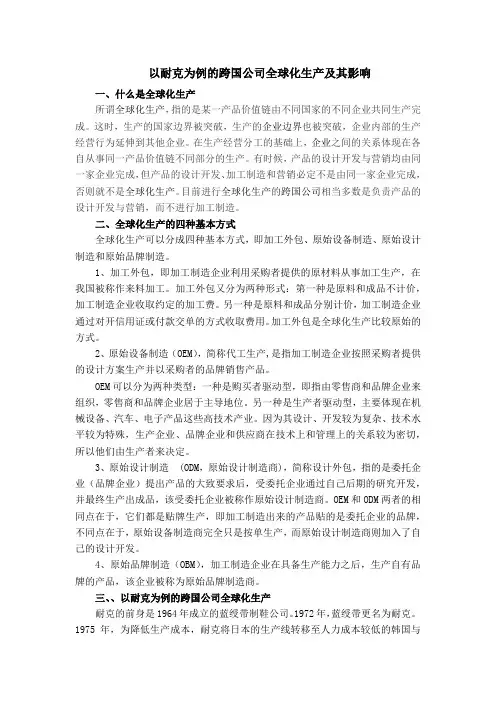
以耐克为例的跨国公司全球化生产及其影响一、什么是全球化生产所谓全球化生产,指的是某一产品价值链由不同国家的不同企业共同生产完成。
这时,生产的国家边界被突破,生产的企业边界也被突破,企业内部的生产经营行为延伸到其他企业。
在生产经营分工的基础上,企业之间的关系体现在各自从事同一产品价值链不同部分的生产。
有时候,产品的设计开发与营销均由同一家企业完成,但产品的设计开发、加工制造和营销必定不是由同一家企业完成,否则就不是全球化生产。
目前进行全球化生产的跨国公司相当多数是负责产品的设计开发与营销,而不进行加工制造。
二、全球化生产的四种基本方式全球化生产可以分成四种基本方式,即加工外包、原始设备制造、原始设计制造和原始品牌制造。
1、加工外包,即加工制造企业利用采购者提供的原材料从事加工生产,在我国被称作来料加工。
加工外包又分为两种形式:第一种是原料和成品不计价,加工制造企业收取约定的加工费。
另一种是原料和成品分别计价,加工制造企业通过对开信用证或付款交单的方式收取费用。
加工外包是全球化生产比较原始的方式。
2、原始设备制造(OEM),简称代工生产,是指加工制造企业按照采购者提供的设计方案生产并以采购者的品牌销售产品。
OEM可以分为两种类型:一种是购买者驱动型,即指由零售商和品牌企业来组织,零售商和品牌企业居于主导地位。
另一种是生产者驱动型,主要体现在机械设备、汽车、电子产品这些高技术产业。
因为其设计、开发较为复杂、技术水平较为特殊,生产企业、品牌企业和供应商在技术上和管理上的关系较为密切,所以他们由生产者来决定。
3、原始设计制造(ODM,原始设计制造商),简称设计外包,指的是委托企业(品牌企业)提出产品的大致要求后,受委托企业通过自己后期的研究开发,并最终生产出成品,该受委托企业被称作原始设计制造商。
OEM和ODM两者的相同点在于,它们都是贴牌生产,即加工制造出来的产品贴的是委托企业的品牌,不同点在于,原始设备制造商完全只是按单生产,而原始设计制造商则加入了自己的设计开发。

耐克生产外包案例分析当耐克将自己全部的生产任务外包时,日本曾经警告过美国:长此以往,美国的制造能力会被极度削弱,美国会失去其强国的根本。
但事实是,美国依旧凭借其技术创新能力位居强国之首,而耐克也凭借其研发与营销能力,在运动服领域是名副其实的“老大”。
本案例将分析耐克的生产外包策略,其强大的研发与营销能力是其实施生产外包的强大后盾。
背景介绍:如今,提起运动鞋就势必会提到耐克(NIKE),多年来,耐克鞋在全球范围内畅销不衰。
然而,耐克公司从一家小作坊成长为国际性的大企业却经历了很多的磨难。
耐克的创始人菲尔R26;奈特是一位并不出众的赛跑运动员,比尔R26;鲍尔曼是俄勒冈大学的体育教师,对运动鞋的共同兴趣事他们成为了好朋友。
1960年,奈特获得斯坦福大学工商管理硕士学位后就前往日本,到奥尼楚卡公司申请在美国销售泰格尔跑鞋的资格。
回到美国时,他把该公司的鞋的样品带给了鲍尔曼。
1964年奈特和鲍尔曼合伙,各拿出500美元开办了蓝带体育用品公司,为泰格尔跑鞋生产鞋底。
为了节约租房的开支,他们没有租店面,而是沿街叫卖,一年便销售了8000美元的进口鞋,他们的鞋大多数卖给了中学的体育队。
1966年,鲍尔曼首次将自己设计的新式跑鞋寄给日本公司,由日本公司制造,这种后来被称为“科泰玆”(Cortez)的鞋在美国西北各州的田径赛圈中引起了空前的轰动,成为当时最畅销的产品,为公司的发展打下了财务基础。
1971年,蓝带体育用品公司开始有了自己的运动鞋生产线。
6年内,公司资产增加了数倍,员工数发展到了45人,而第一家蓝带体育用品公司的零售店也在加利福尼亚的Santa Monica开业。
1972年,奈特和鲍尔曼给自己生产的鞋取名为“耐克”(NIKE),这正是希腊“胜利女神”的名字,意为“取胜”。
同时他们还发明出一种独特标志Swoosh,意为“嗖的一声”,简单的标识像是一个精彩的对勾,极为醒目、独特,每件耐克公司的产品上都有这个标识。
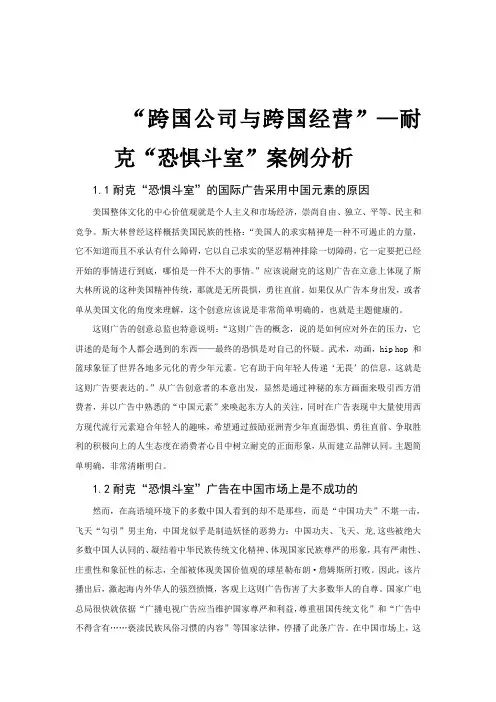
“跨国公司与跨国经营”—耐克“恐惧斗室”案例分析1.1耐克“恐惧斗室”的国际广告采用中国元素的原因美国整体文化的中心价值观就是个人主义和市场经济,崇尚自由、独立、平等、民主和竞争。
斯大林曾经这样概括美国民族的性格:“美国人的求实精神是一种不可遏止的力量,它不知道而且不承认有什么障碍,它以自己求实的坚忍精神排除一切障碍,它一定要把已经开始的事情进行到底,哪怕是一件不大的事情。
”应该说耐克的这则广告在立意上体现了斯大林所说的这种美国精神传统,那就是无所畏惧,勇往直前。
如果仅从广告本身出发,或者单从美国文化的角度来理解,这个创意应该说是非常简单明确的,也就是主题健康的。
这则广告的创意总监也特意说明:“这则广告的概念,说的是如何应对外在的压力,它讲述的是每个人都会遇到的东西——最终的恐惧是对自己的怀疑。
武术,动画,hip hop 和篮球象征了世界各地多元化的青少年元素。
它有助于向年轻人传递‘无畏’的信息,这就是这则广告要表达的。
”从广告创意者的本意出发,显然是通过神秘的东方画面来吸引西方消费者,并以广告中熟悉的“中国元素”来唤起东方人的关注,同时在广告表现中大量使用西方现代流行元素迎合年轻人的趣味,希望通过鼓励亚洲青少年直面恐惧、勇往直前、争取胜利的积极向上的人生态度在消费者心目中树立耐克的正面形象,从而建立品牌认同。
主题简单明确,非常清晰明白。
1.2耐克“恐惧斗室”广告在中国市场上是不成功的然而,在高语境环境下的多数中国人看到的却不是那些,而是“中国功夫”不堪一击,飞天“勾引”男主角,中国龙似乎是制造妖怪的恶势力:中国功夫、飞天、龙,这些被绝大多数中国人认同的、凝结着中华民族传统文化精神、体现国家民族尊严的形象,具有严肃性、庄重性和象征性的标志,全部被体现美国价值观的球星勒布朗·詹姆斯所打败。
因此,该片播出后,激起海内外华人的强烈愤慨,客观上这则广告伤害了大多数华人的自尊。
国家广电总局很快就依据“广播电视广告应当维护国家尊严和利益,尊重祖国传统文化”和“广告中不得含有……亵渎民族风俗习惯的内容”等国家法律,停播了此条广告。

1. What is the WACC and why is it important to estimate a firm’s cost of capital? Do you agree with Joanna Cohen’s WACC calculation? Why or why not?1.1 The definition of WACCWeighted average cost of capital(WACC), is a weighted-computational method of analyzing the cost of capital based on the whole capital structure of a firm. The result of WACC is the rate a firm use to monitor the application of the current assets because it represents the return the firm MUST get. For example this rate could be used as the discount rate of evaluating an investment, and maintaining the price of firm’s stock.1.2 Analysis of Johanna Cohen’s calculationWe analyzed the process of Johanna Cohen’s calculation, and found some flaws we believe caused computational mistakes.i. When using the WACC method, the book value of bond is available as themarket value since bonds are not quite active in the market, but the book value of equity isn’t. Instead of Johanna’s using equity’s book value, we should multiply the current price of Nike’s stock price by the numbers of shares outstanding.ii. When calculating the YTM of the firm’s bond, Johanna only used the interest expense of the year divided by the average debt balance, which fully ignored the discounted cash flow of the cost of debt.2. If you do not agree with Cohen’s analysis, calculate your own WACC for Nike and be prepared to justify your assumptions. Combining the analysis above, we now give our own WACC calculation as following: 2.1 The value of debt(based on EXIHIBIT 3).Since the book value of debt may represent the market value, we merely need to sum up the values of Long-term debt, Notes payable, and the Current portion of long-term debt:435.9+855.3+5.4=$1,296.6 m2.2 The cost of debt (based on EXIHIBIT 4):PV: -95.6FV: 100n: 40Pmt: 6.75/2= 3.375 (as it pays semiannually)So, we get the YTM is i*2=3.58*2=7.16%2.3 The value of equity (based on EXIHIBIT 1&4):Price of stock * numbers of shares outstanding= 42.09*273.3=$11,503.2m2.4 The cost of equity (based on EXIHIBIT 4):E(R i) = R f +【E(R m) - R f】* βiBecause the government bond yield is 5.74%, Geometrical historical risk premium is 5.90%, and the average historical βof Nike is 0.80, then we get:E(R i)= 5.74%+5.90%* 0.8=10.46%2.5 Weights of each security (based on 2.1&2.3)Weight of debt=1,296.6/(1,296.6+11,503.2)=10.13%Weight of equity=11427.44/(1,296.6+11,503.2)=89.87%2.6 Cost of capital by WACC method (based above):Cost of capital = Weight of debt * Cost of debt * (1 – Tax rate) + Weight of equity * Cost of equity = 10.13% * 7.16%* (1-0.38) + 89.87% * 10.46% = 9.85%3. Calculate the costs of equity using CAPM, the dividend discount model, and the earnings capitalization ratio. What are the advantages and disadvantages of each method?3.1 Calculating the costs of equity by CAPM, and its advantages & disadvantagesi. Calculation:According to 2.4, we have already got the result of CAPM, which is 10.46%.ii. AdvantagesFirst, because CAPM is a theory based on the whole market, it obviously includes the effects between the market as the integrity and each individual stock. Second, with the counterbalance among each stock in the entire market, CAPM only needs the consideration of systematic risk, which much simplifies the calculation. Third, CAPM also bypasses the specific values of future cash flow because the equation is actually the relation between systematic risk and return rate, which is also another simplification of calculating. Fourth, merely depending on the systematic risk, CAPM could offer the investors a reliable discounting rate to assess the value of a certain investment.iii. Disadvantages:First, involving the counterbalance among the entire market, CAPM acquiesces an effective, active and healthy market environment. Second, comparing the consideration of market risk, CAPM may omit the subtle risk differences among each single firm. Third, the crucial systematic risk, the beta coefficient, is obviously hard to calculate.3.2 Calculating the costs of equity by DDM, and its advantages & disadvantagesi. Calculation (based on EXIHIBIT 4)::Based on the dividend discount model, P0 = D0 * (1+g) / (k – g), then we get the return rate (the cost of equity) k = D0 * (1+g) / P0 + g = 0.48 * (1 + 0.055) /42.09 + 0.055 = 6.7%ii. AdvantagesFirst, DDM fully considers the time value of consistent cash flow of an investment. Second, it is pretty easy to get the necessary historical data. Third DDM is flexible enough for the adjustment of any future situation. Fourth, once the growth pattern is confirmed, it is very straightforward to get the discount rate of assessing an investment.iii. DisadvantagesFirst, without enough consideration of risk cost, DDM may underestimate theequity cost. Second, all of the data is based on historical record, so the resultis not reliable considering of the future situations. Third, with thepredetermined growth rate, it is obviously practical for the stock investors toestimate the possible profit, but may mislead the stock issuing firm from abetter budgeting decision to a comparatively unsubstantial investment.3.3 Calculating the costs of equity by the earnings capitalization ratio, and itsadvantages & disadvantagesi. Calculation (based on EXIHIBIT 1&4)According to the earnings capitalization model, we have cost of equity = E1 / P0 = 2.16 / 42.09 = 5.13%ii. AdvantagesFirst, it’s very e asy to calculate and understand. Second, it’s easy to get the necessary accounting dataiii. DisadvantagesWithout any consideration of the risk and the growth of the firm, it doesn’t reflect the true value of an investment or the cost of the budgeting at all.4. What should Kimi Ford recommend regarding an investment inNike?According to EXIHIBIT 2, the market’s forecasting sensitivity of equi ty value of Nike is 11.17%. But based on our own analysis by WACC, we believe the discount rate of Nike is around 9.85%. That means the market underestimated the value of Nike. So we recommend the Northpoint to purchase the stock of Nike.。
【案例研究】耐克公司资料耐克公司在中国1972 年 NIKE公司正式成立。
其前身是由现任NIKE总裁菲尔耐特(Philip Knight)以及比尔鲍尔曼教练投资的蓝带体育公司。
1973 年全美2000米到10000米跑记录创造者佩里方庭成为第一个穿NIKE运动鞋的田径运动员。
1978 年 NIKE国际公司正式成立。
NIKE鞋开始进入加拿大、澳大利亚、欧洲和南美等海外市场。
1979 年第一款运用NIKE专利气垫技术的Thaiwind跑步鞋诞生。
第一条NIKE服装生产线开始上马。
1980 年 NIKE进入中国,在北京设立了第一个NIKE生产联络代表处。
之后,NIKE秉承“Local for Local”(在哪里,为哪里)的观念,不仅将先进技术引入中国,而且全心致力于本地人才、生产技术、销售观念的培养,取之本地,用之本地,在中国取得了飞速进展。
1996 年正式在中国成立了全资子公司NIKE(苏州)体育用品有限公司,总部设于上海,并在北京、广州设立分公司(香港也于2002年1月作为分公司并入中国区)。
2002年5月 NIKE开始在全国范围内举办NIKE蝎斗3对3足球赛,数百支青少年球队在广州、上海、北京三地分别角逐14、16、18岁三个级别的奖牌。
这是NIKE公司为中国青少年体育发展做出的又一盛举。
2002年7月 NIKE特邀被冠以“放客博士”之称的NBA巨星文斯〃卡特来京,卡特此行的目的是为了支持中国青少年篮球事业,传播放客文化。
2002年8月耐克将会赞助一批代表美国自由篮球文化的“街头炫技篮球少年”来中国,跟中国的同龄人切磋球技。
跨国公司全球化战略的案例分析与思考第一章概述跨国公司全球化战略是指面对竞争激烈的国际市场,为了在全球范围内获取更多的市场份额和资源,跨国公司制定的一系列战略措施。
全球化战略的成功与否关系到公司的未来发展,本章将从案例分析与思考的角度,探讨几个典型的跨国公司全球化战略。
第二章耐克公司耐克是全球领先的体育用品制造商,采取了一系列全球化战略来扩大市场份额。
首先,耐克通过出口模式进军国际市场,并在全球设立生产基地,以降低成本。
其次,耐克采取了市场扩张战略,通过私人品牌定位,推出符合当地消费者需求的产品。
再次,耐克注重品牌营销,通过赞助体育明星和体育赛事,提升品牌知名度和美誉度。
最后,耐克通过并购和合作,加强与供应商和零售商的合作关系,实现全球供应链的高效运作。
第三章谷歌公司作为全球最大的互联网公司之一,谷歌通过全球化战略实现了强势增长。
首先,谷歌采取了全球性的研发战略,将研发中心分布在全球各地,不断推出创新产品和服务。
其次,谷歌通过全球化市场拓展战略,将搜索引擎服务本土化,提供当地化的搜索结果和广告服务。
再次,谷歌注重跨国并购,通过收购具有潜在价值的公司,扩大市场份额。
最后,谷歌积极参与社会责任项目,提升公司形象,促进全球化发展。
第四章马自达公司马自达是日本汽车制造商,通过全球化战略实现了市场转型。
首先,马自达采取了全球研发战略,不断推出符合全球消费者需求的新产品,如节能环保型汽车。
其次,马自达通过跨国并购和合资合作,进入新兴市场并扩大销售渠道。
再次,马自达注重品牌重塑,通过重新设计标志和产品造型,提升品牌形象和认知度。
最后,马自达通过整合全球供应链,实现高效运作,降低生产成本。
第五章思考与启示跨国公司全球化战略的案例分析为我们提供了许多启示。
首先,全球化战略需要根据不同市场的特点来制定,必须与当地需求相符。
其次,商品的本土化是全球化成功的关键,必须满足当地消费者的文化、习俗和偏好。
再次,品牌建设和市场营销是全球化战略的重要组成部分,必须建立和维护强大的品牌形象。
耐克独特的生产经营模式和其产品的劳动密集型生产技术特征导致耐克公司面临独特的社会责任问题。
首先,耐克公司面临的社会问题与其自身的核心经营活动即研发与营销没有直接关系,而主要是与其关联的全球的合作厂商的社会责任问题。
其次,劳动密集型的生产技术特征使得耐克既不面战略管理案例分析作业跨国企业与其代工厂的社会责任问题——基于耐克“血汗工厂”案例大企业在全球化过程中越来越多地将生产制造环节分布在多个国家,这些国家的生产条件比其公司总部恶劣得多。
随着一些NGO组织对网络媒体的利用,大企业在很落后的国家设立的生产部门的信息也会在社会媒体上得到揭露,使得人们可以很便利的了解企业社会责任的承担情况。
比如壳牌石油在尼日利亚的石油泄漏和Nike的亚洲分包商的“血汗工厂”般的生产条件都是通过媒体揭露从而引发了社会讨论。
一、耐克独特的生产经营模式耐克公司是全球第一大体育用品公司,它的成功在于它在产品设计和营销两个环节上的巨大投入,而把生产制造环节完全外包。
耐克的直接雇员只有约两万人,但非直接雇佣的雇员却遍布46个国家的565个合约工厂,总数达到了近50万人。
耐克牢牢控制产品设计和营销两个核心环节,耐克的创始人将耐克定义成“营销导向企业”,足见其将营销在其企业战略中的重要地位。
因为耐克深知体育用品作为一种功能性产品,只有不断在产品工艺、新功能上创新,才能满足专业运动员对于装备的需求和业余爱好者对于潮流的追求。
通过将设计和营销两个核心环节放在美国本土,耐克充分利用了美国成熟的市场和资源优势。
明星效应和美国文化的强势入侵,使得耐克的代言人著名篮球运动员迈克尔·乔丹和高尔夫明星泰格·伍兹的形象在全世界范围内都深入人心。
与得到直接控制的设计和营销环节截然相反的是耐克的生产和制造环节。
现代的运动鞋由网眼材料、皮革和尼龙鞋帮构成,这些部件都需要手工组装、缝制并用胶水粘合才能组成一双万丈的运动鞋。
由于材料的易碎性和运动鞋款型更新很快,机械化并不适用于球鞋的生产。